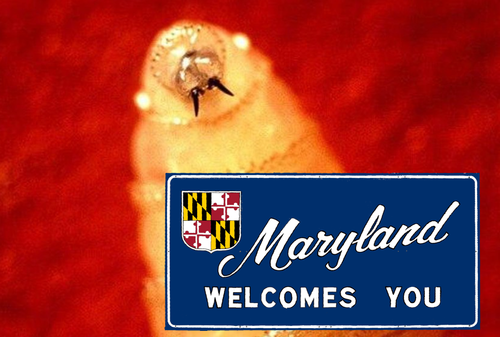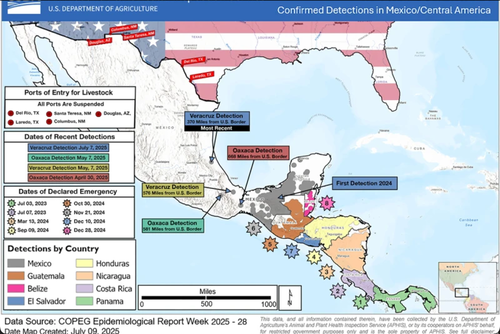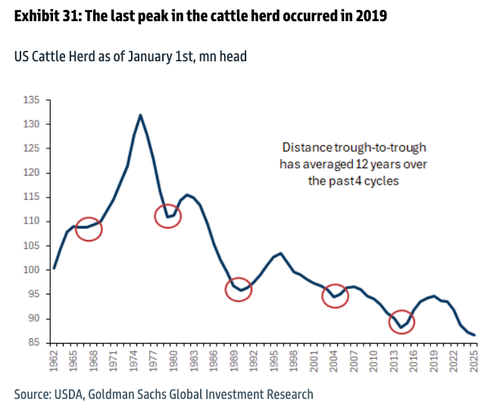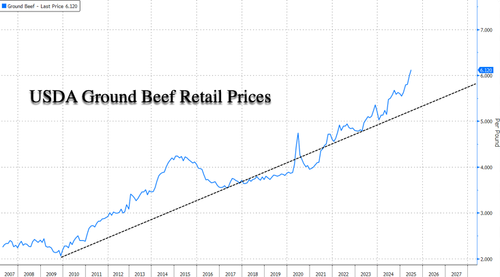
Первый случай употребления в пищу плоти червя обнаружен в штате Мэриленд
Министерство здравоохранения и социальных служб США (HHS) сообщило о первом человеческом случае связанного с путешествиями червя New World в Мэриленде после того, как «пациент» вернулся из Сальвадора, сообщает Reuters со ссылкой на представителя HHS Эндрю Г. Никсона. Подробности об иммиграционном статусе пациента не были обнародованы, хотя стоит отметить, что Мэриленд является оплотом крайне левой Демократической партии и государством-убежищем.

С 2023 года черви перемещаются на север из Центральной Америки через Мексику, а новый случай был обнаружен в июле примерно в 400 милях к югу от границы США в Веракрусе. Министерство сельского хозяйства США (USDA) приняло решение о прекращении трансграничной деятельности портов для перевозки крупного рогатого скота в США, чтобы смягчить угрозу биобезопасности.

Более подробная информация из отчета Reuters:
HHS сообщил о первом случае заболевания человека, связанного с путешествиями, в США, Центры по контролю и профилактике заболеваний (CDC) подтвердили наличие паразита 4 августа у пациента, возвращающегося из Сальвадора.
Ранее источники в отрасли сообщили Reuters, что пациент прибыл из Гватемалы, а письма Beef Alliance распространили эту версию среди заинтересованных сторон в животноводстве. HHS не уточнила расхождения.
HHS говорит, что риск для общественного здравоохранения США очень низок. В этом году в США не было зарегистрировано ни одного случая заболевания животных.
Для людей инвазивные черви устойчивы к лечению, но это первый случай в США, который вызвал тревогу у чиновников здравоохранения и животноводческой промышленности. Оставленные без лечения, эти паразиты могут убивать хозяев, таких как крупный рогатый скот, дикая природа и домашние животные.
Вот ответ USDA на данный момент:
Стерильная муха: Министр сельского хозяйства США Брук Роллинс недавно объявила о планах создания нового стерильного летающего объекта в Техасе (база ВВС Мура), смоделированного по образцу прошлых кампаний по искоренению. Строительство объекта займет 2-3 года.
Мексика также строит завод по производству стерильных мух на юге страны стоимостью 51 миллион долларов. В настоящее время существует только одно растение (Панама-Сити), производящее 100 миллионов стерильных мух в неделю, но 500 миллионов необходимы для того, чтобы отодвинуть заражение обратно в Дарьен-Гап.
По оценкам Министерства сельского хозяйства США, вспышка чучела в Техасе может привести к разрушению животноводческой отрасли, что приведет к потерям в 1,8 миллиарда долларов в результате гибели скота, затрат на рабочую силу и лечение. Биоугроза наступает в то время, когда стадо крупного рогатого скота в стране является самым маленьким за 70 лет, цены на говядину находятся на рекордно высоком уровне, а маржа кормовых площадок остается чрезвычайно низкой.

Сочетание факторов, включая сокращение стад, засухи, тарифы, подталкивает цены на говядину в супермаркете к рекордным уровням.

Хорошие новости:
- 12 лет Цикл крупного рогатого скота: генеральный директор Tyson предсказывает начало фазы восстановления в следующем году
Министерство сельского хозяйства США официально классифицирует червей как «угрозу сельскохозяйственной биобезопасности», и приходится удивляться, учитывая недавние случаи, когда китайские граждане были пойманы за контрабандой грибов «агротерроризма» в страну, могут ли эти паразиты быть вооружены в рамках гибридной войны иностранными противниками.
Тайлер Дерден
Мон, 08/25/2025 - 20:30















